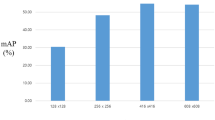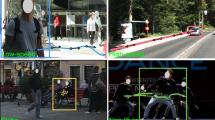Abstract
This paper proposes low power VLSI architecture for motion tracking that can be used in online video applications such as in MPEG and VRML. The proposed architecture uses a hierarchical adaptive structured mesh (HASM) concept that generates a content-based video representation. The developed architecture shows the significant reducing of power consumption that is inherited in the HASM concept. The proposed architecture consists of two units: a motion estimation and motion compensation units.
The motion estimation (ME) architecture generates a progressive mesh code that represents a mesh topology and its motion vectors. ME reduces the power consumption since it (1) implements a successive splitting strategy to generate the mesh topology. The successive split allows the pipelined implementation of the processing elements. (2) It approximates the mesh nodes motion vector by using the three step search algorithm. (3) and it uses parallel units that reduce the power consumption at a fixed throughput.
The motion compensation (MC) architecture processes a reference frame, mesh nodes and motion vectors to predict a video frame using affine transformation to warp the texture with different mesh patches. The MC reduces the power consumption since it uses (1) a multiplication-free algorithm for affine transformation. (2) It uses parallel threads in which each thread implements a pipelined chain of scalable affine units to compute the affine transformation of each patch.
The architecture has been prototyped using top-down low-power design methodology. The performance of the architecture has been analyzed in terms of video construction quality, power and delay.
Similar content being viewed by others
References
A. Nosratinia, “New Kernels for Fast Mesh-Based Motion Estimation,” IEEE Transactions on Circuits and Systems for Video Technology, vol. 11, no. 1, 2001, pp. 40-52.
R.M. Haralick, “Automatic Remote Sensor Image Processing,” in Topics in Applied Physics, vol. 11: Digital Picture Analysis. New York: Springer-Verlag, 1976, pp. 5-63.
G.J. Holzmann, Beyond Photography—The Digital Dark-Room. Englewood Cliffs, NJ: Prentice-Hall, 1988.
G. Wolberg, Digital Image Warping. Los Almitos, CA: IEEE Computer Society Press, 1990.
H. Bruzewitz, “Motion Compensation with Triangles,” in Proc. 3rd Int. Conf. 64 kbit Coding of Moving Video, Rootterdam, The Netherlands, Sept. 1990.
G.J. Sullivan and R.L. Baker, “Motion Compensation for Video Compression Using Control Grid Interpolation,” in Proc. IEEE ICASSP, vol. 4, May 1991, pp. 2713-2716.
Y. Nakaya and H. Harashima, “An Iterative Motion Estimation Method using Triangular Patches for Motion Compensation,” in Proc. SPIE Visual Communications and Image Processing, vol. 1605, Nov. 1991, pp. 546-557.
Y. Nakaya and H. Harashima, “Motion Compensation Based on Spatial Transformations,” IEEE Trans. Circuits Syst. Video Technol., vol. 4, 1994, pp. 339-356.
J. Nieweglowski, T. Campbell, and P. Haavisto, “A Novel Video Coding Scheme Based on Temporal Prediction Using Digital Image Warping,” IEEE Trans. Consumer Electron., vol. 39, 1993, pp. 141-150.
C.L. Huang and C.Y. Hsu, “A New Motion Compensation Method for Image Sequence Coding Using Hierarchical Grid Interpolation,” IEEE Trans. Circuits Syst. Video Technol., vol. 4, 1994, pp. 42-52.
Y. Wang and O. Lee, “Active Mesh—A Feature Seeking and Tracking Image Sequence Representation Scheme,” IEEE Trans. Image Processing, vol. 3, 1994, pp. 610-624.
Y. Wang and O. Lee, “Use of Two-Dimensional Deformable Mesh Structures for Video Coding, Part I—The Synthesis Problem: Mesh-Based Function Approximation and Mapping,” IEEE Tran. Circuits Syst. Video Technol., vol. 6, 1996, pp. 636-646.
Y. Wang, O. Lee, and A. Vetro, “Use of Two-Dimensional Deformable Mesh Structures for Video Coding, Part II—The Analysis Problem and a Region-Based Coder Employing an Active Mesh Representation,” IEEE Trans. Circuits Syst. Video Technol., vol. 6, 1996, pp. 647-659.
Y. Wang and J. Osterman, “Evaluation of Mesh-Based Motion Estimation in h.263 like Coders,” IEEE Trans. Circuits Syst. Video Technol., vol. 8, 1998, pp. 243-252.
A.M. Tekalp, P.J.L. van Beek, C. Toklu, and B. Gunsel, “2d Mesh-Based Visual Object Representation for Interactive Synthetic/Natural Video,” Proc. IEEE, vol. 86, 1998, pp. 1029-1051.
C. Toklu, A. Erdem, M.I. Sezan, and A.M. Tekalp, “Tracking Motion and Intensity Variations Using Heirarchical 2d Mesh Modeling for Synthetic Object Transfiguration,” Graphic Models and Image Processing, vol. 58, 1996, pp. 553-573.
A. Nosratinia, N. Mohsenian, M.T. Orchard, and B. Liu, “Interslice Coding of Magnetic Resonance Images Using Deformable Triangular Patches,” in Proc. IEEE ICIP, Austin, TX, Nov. 1994, vol. 2, pp. 898-892.
A. Nosratinia, N. Mohsenian, M.T. Orchard, and B. Liu, “Interframe Coding of Magnetic Resonance Images,” IEEE Trans. Medical Imaging, vol. 15, 1996, pp. 639-647.
N. Mohsenian, A. Nosratinia, B. Liu, and M.T. Orchard, “Adaptive Entropy Constrained Transform Coding of Maggetic Resonance Image Sequences,” IEEE Trans. Nuclear Sci., vol. 42, 1995, pp. 2309-2316.
O. Lee and Y. Wang, “Non-Uniform Image Sampling and Interpolation Over Deformed and Its Hierarchical Extension,” International Conference on Visual Communications and Image Processing, vol. 3, 1995, pp. 289-300.
W. Badawy and M. Bayoumi, “On Minimizing Hierarchical Mesh Coding Overhead: (HASM) Hierarchical Adaptive Structured Mesh Approach”, in IEEE International Conference on Acoustics, Speech, and Signal Processing, ICASSP, Istanbul, Turkey, June 5–9, 2000, pp. 1923-1926.
D. Terzopoulos and M. Vailescu, “Sampling and Reconstruction using Adaptive Meshes,” IEEE International Conference on Computer Vision and Pattern Recognition CVPR'91, 1991, pp. 70-75.
K.J.R. Liu et al., “Algorithm-Based Low Power and High-Performance Multimedia Signal Processing,” Proc. of IEEE, vol. 86, no. 6, 1998, pp. 1155-1202.
F. Rocca and S. Zanoletti, “Bandwidth Reduction via Movement Compensation on a Model of the Random Video Process,” IEEE trans. Comm. vol. Com 20. 1972, pp. 960-965.
S. Brofferio and F. Rocca, “Interframe Redundancy Reduction of Video Signals Generated by Translating Objects,” IEEE Trans. Commun. vol. Com-25, April 1977, p. 448055.
S.A. Khan and V.K. Madisetti, “System Partitioning of MCM for Low Power,” IEEE Design Test Comput. Mug., vol. 12, Spring 1995, pp. 41-52
A.P. Chandrakasan and R.W. Brodersen, “Minimizing Power Consumption in Digital CMOS Circuits,” in Proc. IEEE, vol. 83, 1995, pp. 498-523.
H.K. Thapar and J. Cioffi, “A Block Processing Method for Designing High Speed Viterbi Decoders,” in Proc. IEEE Communications Conf., June 1989, pp. 1096-1100.
A.P. Chandrakasan, S. Sheng, and R.W. Brodersen, “Low-Power CMOS Digital Design,” in IEEE J. Solid-State Circuits, vol. 27, 1992, pp. 473-484.
T. Koga, K. Iinuma, A. Hirano, Y. Iijima, and T. Ishiguro, “Motion-Compensated Interframe Coding for Video Conferencing,” in Proc. National Telecommun. Conf., New Orleans, LA, 1981, pp. G.5.3.1-G.5.3.5.
J.R. Jam and A.K. Jam, “Displacement Measurement and its Application in Interframe Image Coding,” in IEEE Trans. Commun. vol. COM-29, 1981, pp. 1799-1808.
T.H. Meng, R. Broderson, and D. Messerschmitt, “Asynchronous Design for Programmable Digital Signal Processors,” in IEEE Trans. Signal Processing. vol. 39. 1991, pp. 939-952.
K.I.R. Liu, S.-F. Hsieh, and K. Yao, “Systolic Block Householder Transformation for RLS Algorithm with Two-level Pipelined Implementation,” in IEEE Trans. Acoust., Speech. Signal Processing, vol. 40, 1992, pp. 946-958.
C.L. Wang, “Bit-Serial VLSI Implementation of Delayed LMS Adaptive FIR Filter,” in IEEE Trans. Signal Processing, vol. 42, 1994, pp. 2169-2175.
A.V. Oppenheim and R.W. Schafer, Discrete-Time Signal Processing. Englewood Cliffs, NJ: Prentice-Hall, 1989.
P.E. Eren, C. Toklu, and A.M. Tekalp, “Object-Based Manipulation and Composition Using 2D Meshes in VRML,” in Proc. IEEE Signal Processing 1st Workshop Multimedia Processing, Princeton, NJ, June 1997, pp. 257-261.
G. Wolberg, Digital Image Warping. Los Alamitos, CA: Computer Society Press, 1990.
G. Seetharaman, “Image Sequence Analysis for Three-Dimensional Perception of Dynamic Scenes,” in Handbook of Pattern Recognition and Image Processing: Computer Vision, T.Y. Young (Ed.), Academic Press, 1994, pp. 361-403.
S. Gunasekaran and T.Y. Young, “A Region Correspondence Approach to the Recovery of 3-Dimensional Motion and Structure in Dynamic Scenes,” in Image Understanding in Unstructured Environment, S.-S. Chen (Ed.), World Scientific, 1988, pp. 75-123.
L. Chiariglione, “MPEG and Multimedia Communications,” in IEEE Trans. Circuits Syst. Video Technol., vol. 7, 1997.
H. Ghravi and M. Mile, “Block Matching Motion Estimation Algorithms: New Results,” in IEEE Trans. Circ. and Syst., vol. 37, 1990, pp. 649-651.
H. Benoit-Cattin, A.C. Planat, P.R. Joachimsmann, A. Baskurt, P. Clarysse, and I.E. Magnin, “On Minimizing the Active Mesh Coding,” in IEEE International Conference on Image Processing, 1998, pp. 895-898.
S.K. Rao, M. Hatamian, M.T. Uyttendaele, S. Narayan, J.H. O'Neill, and G.A. Uvieghara, “A Versatile and Powerful Chip for Real Time Motion Estimation,” in Proc. IEEE ISSCC, 1993, pp. 32-33.
K. Ishihara, S. Masuda, S. Hattori, H. Nishikawa, Y. Ajioka, T. Yamada, H. Amishiro, S. Uramoto, M. Yoshimoto, and T. Sumi, “A Half-Pel Precision mpeg2 Motion-Estimation Processor with Concurrent Three-Vector Search,” in IEEE Solid-State Circuits, vol. 30, 1995, pp. 1502-1509.
A. Ohtani, Y. Matsumoto, M. Gion, H. Yoshida, T. Araki, A. Ubukata, M. Serizawa, K. Aoki, A. Sota, A. Nagata, and K. Aono, “A Motion Estimation Processor for mpeg2 Video Real Time Encoding at Wide Search Range,” in Proc. IEEE CICC, 1995, pp. 405-408.
J.F. Shen and L.G. Chen, “Low Power Full-Search Block-Matching Motion Estimation Chip for h.263+,” in Proc. IEEE Circuits and Systems, vol. 4, 1999, pp. 299-302.
K.J.R. Liu et al., “Algorithm-Based Low Power and High-Performance Multimedia Signal Processing,” in Proc. of IEEE, vol. 86, no. 6, 1998, pp. 1155-1202.
W. Badawy and M. Bayoumi, “Algorithm-Based Low Power VLSI Architecture for 2d-Mesh Video Object Motion Tracking,” The IEEE Transaction on Circuits and Systems for Video Technology, vol. 12, no. 4, 2002, pp. 227-237.
G. Wolberg, Digital Image Warping. Los Alamatos, CA: Computer Society Press, 1990.
W. Badawy and M. Bayoumi, “A Low Power VLSI Architecture for Mesh-Based Video Motion Tracking,” The IEEE Transactions on Circuits and Systems II, vol. 49, 2002, pp. 488-504.
P.J.L. van Beek, A.M. Tekalp, and A. Puri, “2D Mesh Geometry and Motion Compression for Efficient Object-Based Video Representation,” Int. Conf. on Image Processing'97, Santa Barbara, CA, Oct. 1997.
G. Fujita, T. Onoye, and I. Shirakawa, “A New Motion Estimation Core Dedicated to h.263 Video Coding,” in Proc. IEEE Circuits and Systems, vol. 2, 1997, pp. 1161-1164.
Author information
Authors and Affiliations
Rights and permissions
About this article
Cite this article
Badawy, W., Bayoumi, M. A Low Power Architecture for HASM Motion Tracking. The Journal of VLSI Signal Processing-Systems for Signal, Image, and Video Technology 37, 111–127 (2004). https://doi.org/10.1023/B:VLSI.0000017006.75431.c7
Published:
Issue Date:
DOI: https://doi.org/10.1023/B:VLSI.0000017006.75431.c7




